Additional notes (click to expand)
Commemorative
Named for Joseph (José) Pavón Jiménez (1754–1840), the Spanish pharmacist/botanist who accompanied Hipólito Ruiz and Joseph Dombey on their epic botanising in Peru and Chile (1777–88) in search of quinine and medicinal plants. On 8 April 1777, King Carlos III of Spain gave permission for the botanists and two artists to travel from Spain to America to study the flora of Peru and Chile, then Spanish dominions. Initially around Lima, and then further afield, they collected plants which their artists painted; they wrote descriptions and pressed herbarium specimens. Apart from a year in Chile (1782–3), about which we know little because all their specimens, diaries, descriptions and paintings for this period were destroyed in a fire, Ruiz
and Pavón stayed in Peru until 31 March 1788, when they returned to Spain, landing in Cadiz on 12 September 1788. Thereafter, they spent years cataloguing their herbarium collection and preparing manuscripts for publication. The Florae Peruvianae, et Chilensis, Prodromus (1794), Systema vegetabilium Florae Peruvianae et Chilensis (1798), and Flora Peruviana et Chilensis (volumes 1–3,
1798–1802) were their completed works, but even before the death of Ruiz (aged 62 in 1816), the project lapsed into chaos. Pavón died in poverty in 1840 at the age of 86. Two of the remaining volumes, volume four in 1954 and volume fi ve (part only) in 1959, were compiled from their manuscript notes. Volumes six and seven await publication.
Oakeley, Dr. Henry. (2012). Doctors in the Medicinal Garden. Plants named after physicians. Royal College of Physicians.
link
Horticulture
Tigridia pavonia is a bulbous perennial from Mexico in the family Iridaceae. In summer, large brightly coloured, exotic looking fl owers appear from dawn to dusk. Although they are thought to be frost tender, we grow it outside, where it survives and self-seeds in a gritty, well-drained sunny border, amongst other plants from arid zones. (Clare Beacham)
Oakeley, Dr. Henry. (2012). Doctors in the Medicinal Garden. Plants named after physicians. Royal College of Physicians.
link
Nomenclature
Tigridia pavonia (L.f.)DC. Iridaceae Distribution: Peru. These colourful, tulip-like flowers were named by De Candolle for Joseph (José) Pavón Jiménez (1754-1840), the Spanish pharmacist/botanist who accompanied Hipólito Ruiz and Joseph Dombey on their epic botanising in Peru and Chile (1777-1788)
Oakeley, Dr. Henry. (2012). Doctors in the Medicinal Garden. Plants named after physicians. Royal College of Physicians.
link
Other use
Tigridia pavonia (L.f.)DC. Iridaceae Distribution: Peru. These colourful, tulip-like flowers were named by De Candolle for Joseph (José) Pavón Jiménez (1754-1840), the Spanish pharmacist/botanist who accompanied Hipólito Ruiz and Joseph Dombey on their epic botanising in Peru and Chile (1777-1788) in search of quinine and medicinal plants. On the 8th April 1777, King Carlos III of Spain gave permission for the three botanists and two artists to travel from Spain to America to study the flora of Peru and Chile, then Spanish dominions. Initially around Lima, and then further afield, they collected plants which their artists painted; they wrote descriptions and pressed herbarium specimens. Apart from a year in Chile (1782-1783), about which we know little because all their specimens, diaries, descriptions and paintings for this period were destroyed in a fire, Ruiz and Pavón stayed in Peru until 31st March 1788, when they returned to Spain, landing in Cadiz on 12th September 1788. On their return to Spain they spent years cataloguing their herbarium collection and preparing manuscripts for publication. The Florae Peruvianae, et Chilensis, Prodromus (1794); Systema vegetabilium Florae Peru et Chilensis (1798) and Flora Peruviana et Chilensis (vol.1-3, 1798-1802) were their completed works, but even before the death of Ruiz, age 62 in 1816, the project lapsed into chaos. Pavón died in poverty in 1840 at the age of 86. Two of the remaining volumes, vol. 4 in 1954 and vol. 5 (part only) in 1959, were compiled from their manuscript notes. Volumes 6 and 7 await publication. The original name for Tigridia pavonia was given by Linnaeus’s son as Ferraria pavonia in 1782, and it was De Candolle, who had access to Ruiz and Pavón’s duplicate herbarium specimens which had been sold to Aylmer Lambert in London, who reclassified it as Tigridia in 1802. Ruiz records in his diary that they found a Ferraria in the gorge of San Mateo de Matucaan in 1779 and in the province of Canta in 1781. Ruiz, while in Chile, records finding Ferraria lagues, a name which appears to have been published as the homophone Ferraria lahue (the Spanish ‘g’ is pronounced like an English ‘h’) and that the bulbs are baked or boiled and taste of hazelnuts. However this is now in Herbertia. Ken Fern writes on www.pfaf.org that the corms of Tigridia pavonia taste like sweet potato when baked, but that they produce a burning sensation in the mouth if eaten raw which suggests that it may contain raphides of calcium oxalate.
Oakeley, Dr. Henry. (2012). Doctors in the Medicinal Garden. Plants named after physicians. Royal College of Physicians.
link
Geographical distribution
- Northern America, Mexico
- Southern America, Central America, El Salvador
- Southern America, Central America, Guatemala
- Southern America, Central America, Honduras
Tigridia pavonia (L.f.) DC.
Family: IRIDACEAEGenus: Tigridia
Species: pavonia (L.f.) DC.
Common names: Tiger Flower
Distribution summary: Meso & South America
Habit: Perennial
Hardiness: H3 - Half hardy; unheated greenhouse/mild winter
Habitat: Pine/Oak forests
Garden status: Currently grown
Garden location: Arid zones (Q)
Flowering months: June, July
Reason for growing: Commemorative
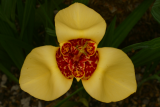
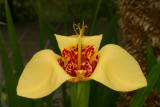

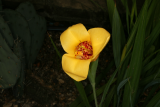
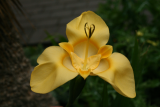
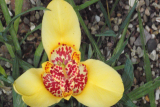
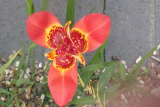



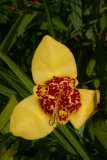
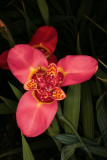

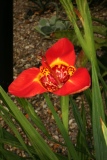
.JPG)